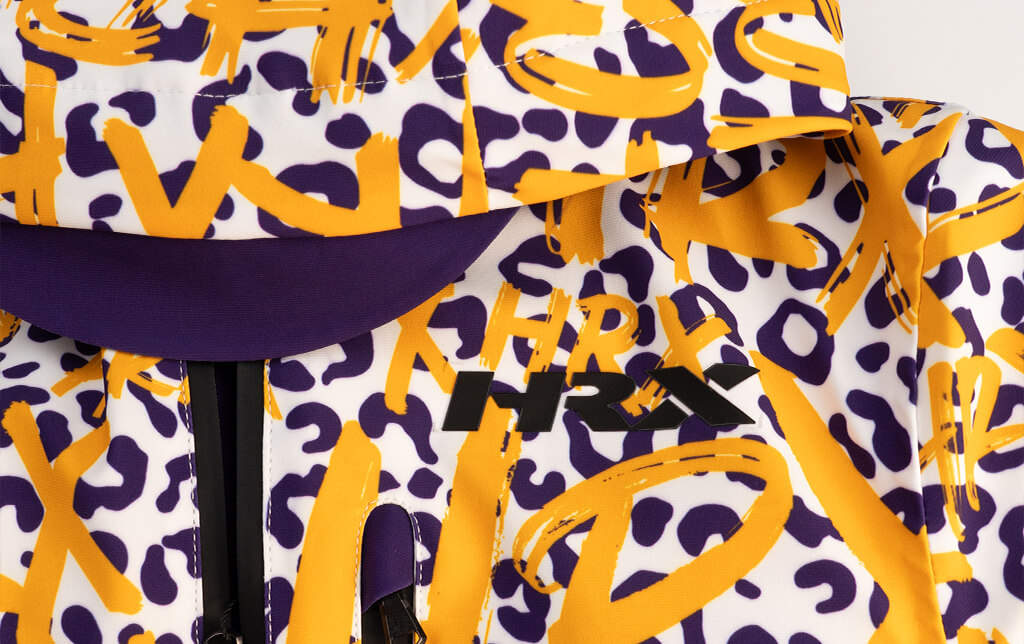You lift the heat press, raise the outdoor jacket – and there it is: that faint, unwanted shine along the sleeve.
The logo sits in place, but the fabric? Heat mark.
Welcome to the reality of many brands, clubs, and manufacturers working with polyamide fabrics (also known as nylon).
The material is lightweight, durable, and weather-resistant – but when it comes to applying logos, it can be surprisingly sensitive.
If you’ve ever wondered why even high-quality transfers sometimes fail on rain jackets or outdoor gear – or why a strong shine appears after pressing – this guide explains what’s happening and how to fix it.
1. The Melting Point – When Fabric Gets Too Much Heat

Polyamide is more heat-sensitive than most technical fabrics. While others can withstand around 200 °C (392 °F), some types of polyamide start to soften and show surface deformation around 150–180 °C (302–356 °F).
The issue: many heat transfers require temperatures in that same range to activate the adhesive.
The result: visible gloss marks, distortion, or even surface melting – especially on dark or matte fabrics.
Particularly critical: structured or layered logos like 3D silicone, embroidery, or woven transfers. They often need longer press times, which increases the risk of heat damage.
The fix: Use low-temperature technologies – transfers with adhesives that activate at lower temperature. That keeps the fabric safe while ensuring strong adhesion. At dekoGraphics, we test every transfer directly on your original fabric – so you know exactly which settings work best.
2. Smooth Surface, Rough Reality

Polyamide fabrics are extremely dense. What provides wind and water protection in outdoor and workwear makes it difficult for adhesives to anchor. Standard transfer adhesives can’t “grip” the surface – the logo may look fine initially but peel off after a few washes.
The fix: Use transfers with specialized PA adhesives (often called nylon adhesives). They are chemically compatible with the fiber structure and remain flexible under movement and stretch.
The result: long-lasting adhesion, even on smooth or coated surfaces.
3. Moisture – Invisible but Impactful

Polyamide can absorb up to 8% of its weight in moisture from the air.
When pressed, that moisture turns to steam – leading to:
- Bubbles under the transfer
- Edge lifting
- Slight warping or shrinkage of the fabric
The fix: Always pre-press the fabric for 3–5 seconds at a low temperature (100–120 °C / 212–248 °F) before applying the transfer. This releases trapped moisture and stabilizes the fabric.
It sounds simple, but this small step often makes the difference between “perfect result” and “rework request.”
4. Chemistry That Doesn’t Match

Here’s what most people overlook: polyamide and polyester have different chemical polarities.
An adhesive that works perfectly on polyester may completely fail on polyamide – because the molecules simply don’t bond.
The fix: Use adhesive systems with matched polarity. Polyamide-optimized hotmelts or silicone-based variants ensure durable adhesion and flexibility, even after repeated washing or stretching.
What does “PA-compatible” mean?
PA stands for polyamide (also known as nylon).
A PA-compatible heat transfer is specifically developed to bond securely to the smooth, dense surface of nylon fabrics. This requires chemically adapted adhesives that form a stable connection with the fiber – not just mechanical grip.
If you’re unsure whether your current transfer is truly PA-compatible, dekoGraphics can test it for you – free of charge and under real production conditions.
5. DWR Isn’t the Main Issue – But It Still Matters

Many assume durable water repellent (DWR) coatings are the main reason transfers won’t stick. But even uncoated polyamide is tricky, simply because it’s naturally denser and smoother than polyester.
The fix: Whether coated or not, always use a PA-optimized adhesive. It offers stronger initial tack and remains elastic – essential when garments are stretched, folded, or exposed to movement and washing.
Practical Tips for Reliable Results

✅ Test on the original fabric. Every textile behaves differently – color, finish, and coating all matter.
✅ Keep temperature and pressure consistent. Use an external thermometer – machine displays can vary by 5–10 °C.
✅ Avoid long press times. Two short cycles with cooling in between are better than one long press.
✅ Keep it clean. Dust, moisture, or residues can weaken adhesion – especially on smooth fabrics
If You Don’t Want to Leave It to Chance
At dekoGraphics, we test every transfer–fabric combination in advance – directly on your original material.
You’ll receive clear, documented results: which technique, which adhesive, and which settings truly work. Especially with polyamide, even small variations can make a big difference in durability and appearance. Just send us your fabric – we’ll handle the testing, document the outcome, and recommend the best transfer type for your product.

Conclusion
Polyamide is a demanding but controllable material. Understanding its behavior prevents heat marks, peeling, and warranty claims. It’s not about more technology – it’s about understanding the interaction between fabric, adhesive, and temperature.
Always test on your actual fabric, use PA-optimized adhesives, and work with a partner who knows technical textiles inside out. Whether you’re aiming for consistent global quality, or working under tight deadlines – the goal is the same: peace of mind in production.
And that begins when technology and textile work in harmony.
👉 Test your polyamide material for free at dekoGraphics.
TRUSTED BY









